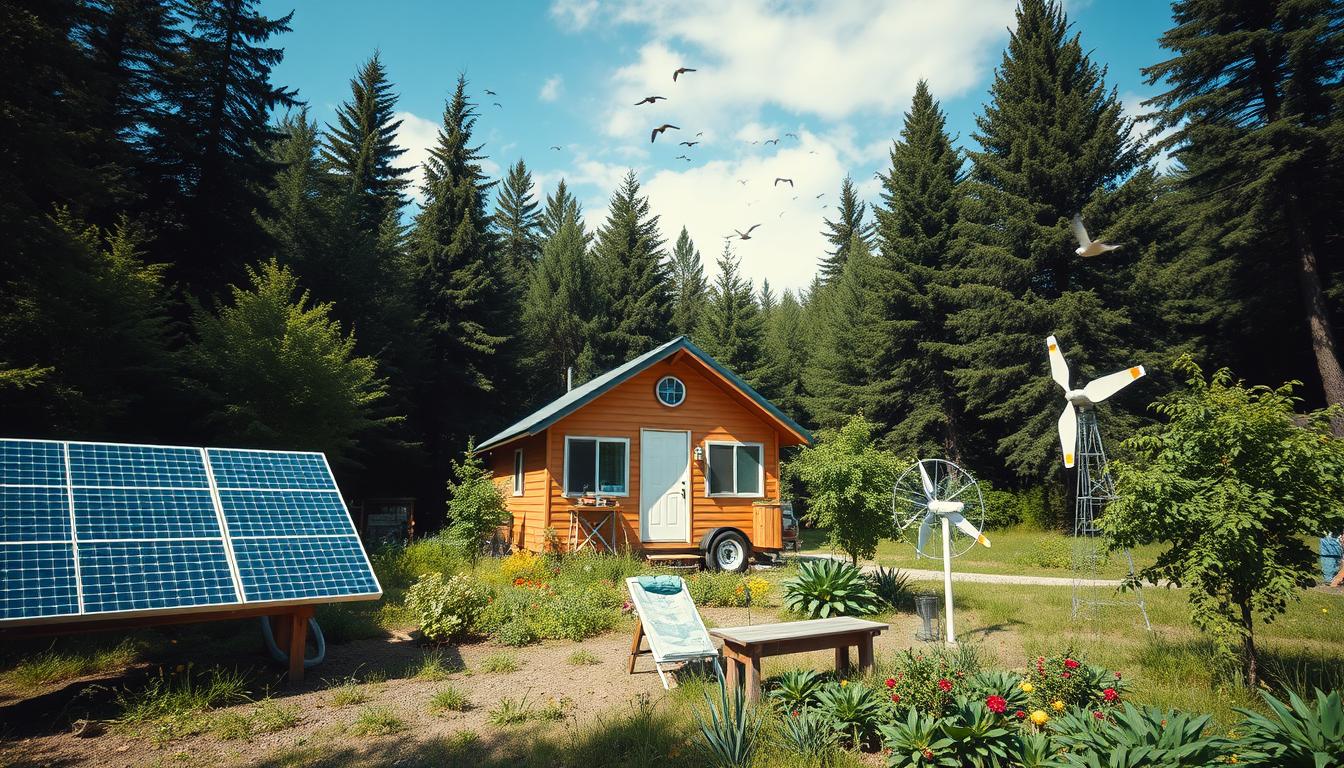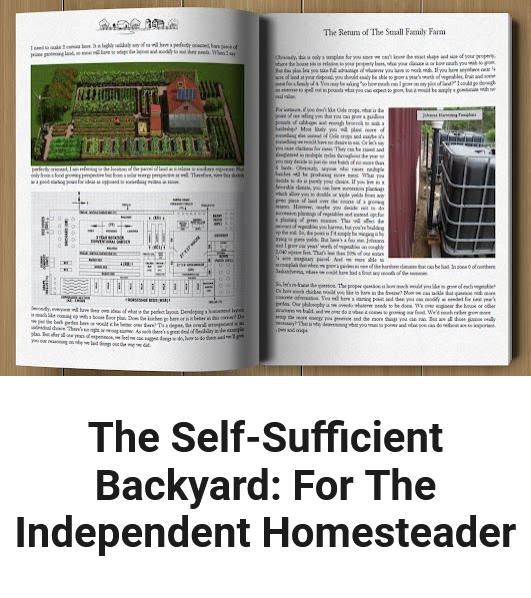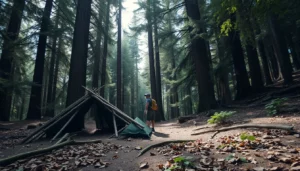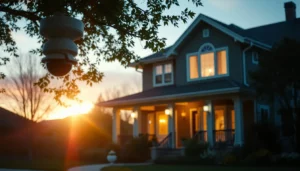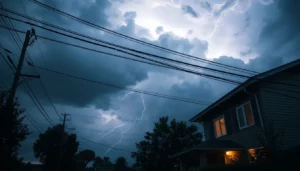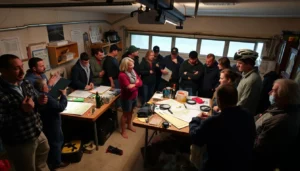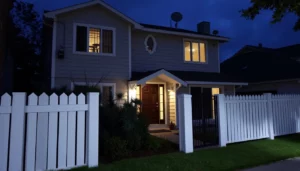Have you ever dreamed of a simpler life? Modern living often makes us feel disconnected from nature and ourselves. Many are now moving towards “off grid living”, powered by renewable energy and free from societal systems.
In 2023, more people want an “eco-friendly lifestyle” and “energy independence”. A significant number are looking to save on electricity costs and lower their carbon footprint. Off grid living is not just about saving money; it’s about living a fulfilling life.
Thanks to solar energy and tiny homes, off grid living is easier now. Building your own *off-grid home* or joining a community lets you connect with nature. You’ll feel more independent and self-sufficient. Activities like harvesting rainwater and growing your own food make the journey rewarding.
This guide will make off grid living easier to understand and start. Let’s look at the basics and how you can start this fulfilling journey.
What is Living Off the Grid?
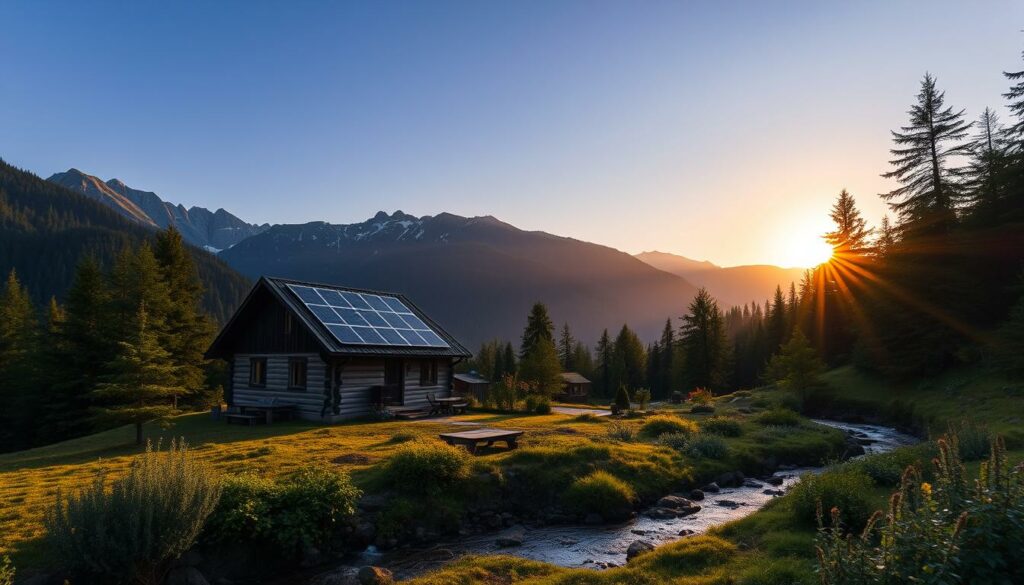
Living off the grid means choosing a life of independence and self-sufficiency. It means not relying on public utilities like food, water, shelter, and energy. It’s about moving towards autonomous living and cutting down on urban dependencies.
Off-grid living is all about being self-sufficient. Many people choose this way of life to lessen their impact on the environment and escape the limits of city living. It includes using renewable energy sources like solar panels and wind turbines for power.
Living remotely requires a detailed plan to meet your basic needs on your own. You might need 1 to 5 acres of land for wood for heating and cooking, and a 6-month growing season for food. Off-grid homes can be small, from 60 to 500 square feet, or larger, up to 1,500 square feet.
Starting an off-grid life can cost between $10,000 and over $75,000, depending on the setup and location. This includes costs for renewable energy sources, water systems, and other needed infrastructure. For example, solar systems can cost from $45,000 to $65,000, and drilling a well is about $5,500.
In the last couple of years, more people are looking into this lifestyle. Whether you want a simple, secluded life or a more modern off-grid home, the aim is the same: to be independent and self-reliant. The perks include saving money, being eco-friendly, and feeling free and fulfilled in a way city living can’t offer.
Benefits of Off Grid Living
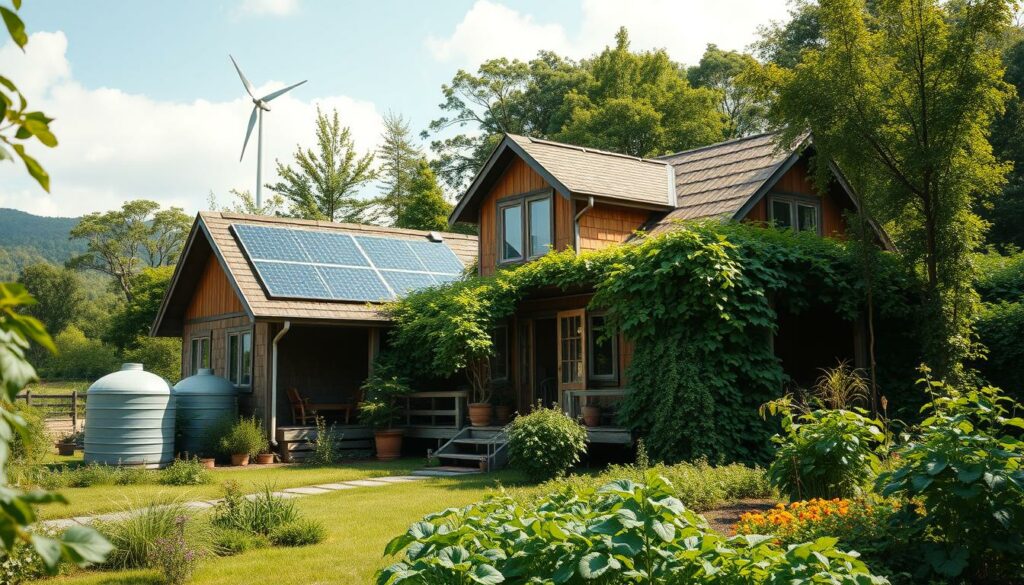
Living off the grid has many benefits. It helps you save money, reduce your carbon footprint, and use sustainable energy.
We are going to talk more about these benefits in details below.
Low Carbon Footprint and Eco-Friendly Lifestyle
Living off the grid cuts down your carbon footprint. You use solar power for energy, which is clean and renewable. This means no greenhouse gases are released.
It also promotes eco-friendly habits. For example, you can use gray water for plants. This water comes from sinks and baths. Plus, you can store over 3,500 gallons of water for up to six months.
Using a compost toilet saves even more water. This is a big step towards being eco-friendly.
Cost-Effectiveness in the Long Run
The start-up costs for off-grid living are high, but you save money over time.
You pay less for utilities like water and electricity. For instance, hauling 200 gallons of water costs less than $10 and takes an hour.
With solar energy, you have power and heat without ongoing bills.
Personal Satisfaction and Mindful Living
Living off the grid brings deep satisfaction and a mindful way of life. You learn what you really need and how it affects the planet. This way of living cuts down on your use of public utilities and makes your life richer.
It’s about being resilient and close to nature. In 2020, over 1.7 billion people lived off the grid, including more than 250,000 in the U.S. Many found better mental and physical health through this sustainable lifestyle.
Finding the Right Location to Start Living Off the Grid
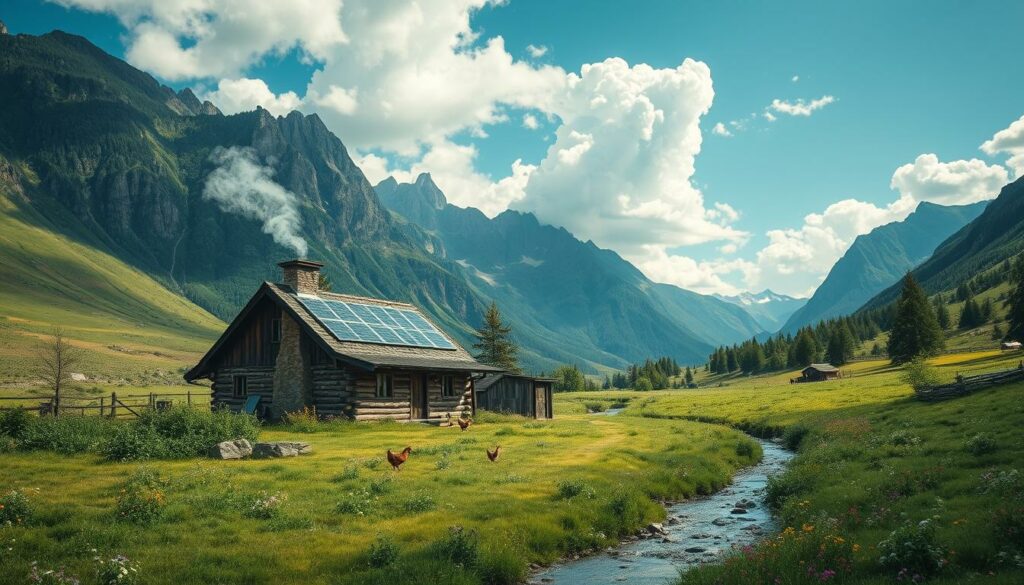
Finding the perfect spot for your remote homesteading journey is key to its success. You need to do your homework and plan well. Make sure your search matches your needs, likes, and legal rules.
Start by setting what you want from your off-grid land. Think about the climate you like, how self-sufficient you want to be, how close you want to be to family, and your budget. Use websites like LandWatch and Land and Farm to look at different properties for sale or rent. Sites like View Point are great for finding land in certain areas, like Nova Scotia.
It’s also important to know about zoning laws and other rules that affect what you can build and use your land for. This keeps your homesteading plans in line with the law. Knowing about zoning laws helps you rule out places that won’t work.
Use tools like Google Maps, Google Earth, and Climate Data to check out potential spots for your off-grid home. Look at the land’s shape, water sources, soil quality, and sunlight. These things are key for building an eco-friendly home and living sustainably.
Don’t just rely on the internet. Check local newspapers, magazines, and talk to people. Social media sites like Reddit and Facebook are great for meeting off-grid folks and getting tips. These sources can give you real advice and stories to help you decide.
Visiting places in person lets you really feel out if they’re right for off-grid living. Talk to locals and other homesteaders, and jot down what you learn. Using lists or scores to compare properties can help you make a choice.
Finding the best land for your remote homesteading means it fits your dreams, legal needs, and resource wants. Think about everything carefully and take steps to find the right land. This will set you up for a rewarding off-grid life.
Building an Off-Grid Home
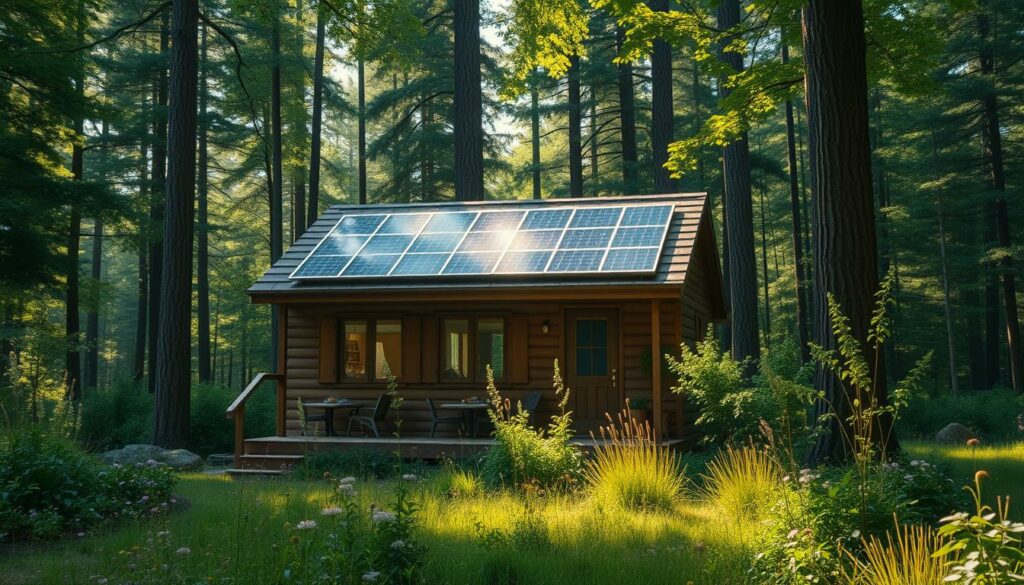
Starting an off-grid life means building a home that’s off the grid.
The tiny home movement is getting popular because it’s good for the planet and saves resources.
These homes, from 60 to 500 square feet, use green building methods like cob, straw bale, or earthbag.
This makes living there affordable and kind to the earth.
Tiny Homes and Eco-Friendly Construction Methods
Joining the tiny home movement lets you build a home that saves energy and uses green building. These homes use materials that cut down on carbon emissions and help with solar heating. Cob homes are well-insulated, straw bale homes keep temperatures steady, and earthbag homes use natural materials to build strong structures.
- Cob Construction: Uses clay, sand, and straw to create durable, energy-efficient walls.
- Straw Bale: Provides excellent insulation, reducing the need for additional heating and cooling.
- Earthbag: Utilizes soil-filled bags, creating a sustainable and sturdy structure.
Passive solar design is key in tiny homes. It uses natural light and warmth to cut down on heating and cooling needs. By placing windows right and using materials that hold heat, you can keep your home cozy all year. Plus, good insulation and air flow help keep temperatures just right.
Tiny homes also let you live life on your terms, whether you’re always moving or staying put. They can be made from old shipping containers or cozy cabins, fitting the green building theme.
When building an off-grid home, think about how to use the sun and other natural resources well. The aim is to build a place that’s good for the planet and supports a simple, thoughtful way of living. Using smart designs and solar power helps you live off the grid while helping the planet.
Generating Power Through Renewable Sources
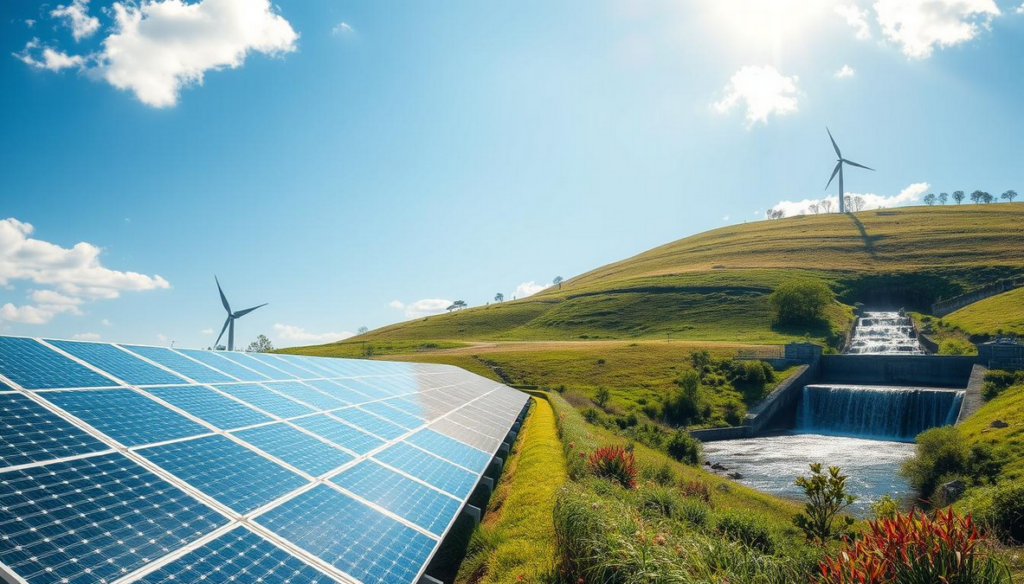
Living off the grid means you need to make your own power. Using renewable power sources helps you be energy independent.
Solar Power Systems and Wind Turbines
Installing solar panels is a great option to supply sustainable and renewable energy for your off-grid home.
Solar panels use the sun’s energy to provide electricity making your system more efficient and saving money over time.
Solar panels are also easy to get for off-grid homes.
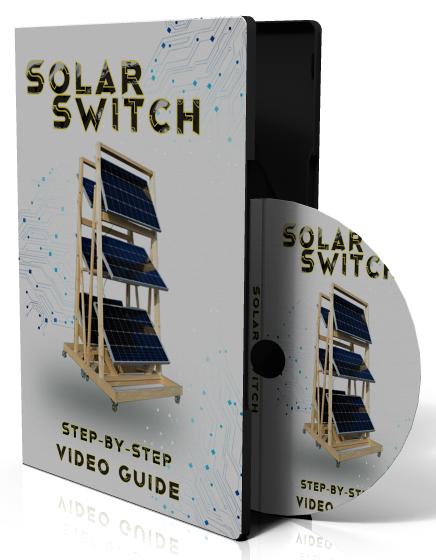
Cut Your Power Bills By 65%!
The simplest, easiest-to-use A to Z blueprint that anyone can follow to make their own cheap green electricity.
Wind energy is another good option. Wind turbines are pricey but work well where the wind is strong, over 9 mph. Government help can make them cheaper. Using both solar and wind power gives you a steady energy supply, even when the sun is hiding.
Adding other renewable sources like micro-hydro or biomass makes your energy system even better. These options help you use less non-renewable energy. This is key to living sustainably.
- Investing in renewable energy is growing, driven by economic and environmental considerations.
- Combining solar and wind energy through hybrid systems enhances reliability for off-grid living.
- Small-scale wind turbines are viable options for residential or remote locations.
Using different renewable energy sources makes a strong and efficient power system. It supports your off-grid life and helps the environment.
Water Supply and Management
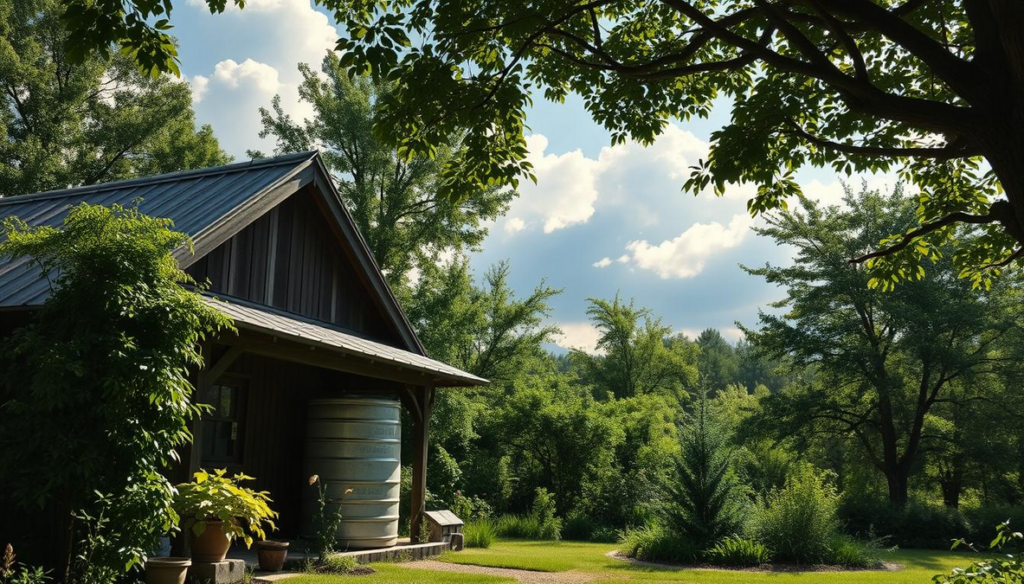
Having clean and reliable water is key for living off the grid. It’s important to conserve water and use eco-friendly ways to purify it. Here are some tips to get a steady water supply and manage it the right way.
Rainwater Harvesting
Rainwater collection is a great way to get water. Each square foot of area can catch about 0.62 gallons of water per inch of rain. Using 55-gallon rain barrels or big cisterns made of safe materials helps store water for later.
Shallow wells, usually under 100 feet deep, give water to over 42 million people in the U.S., says the Groundwater Foundation.
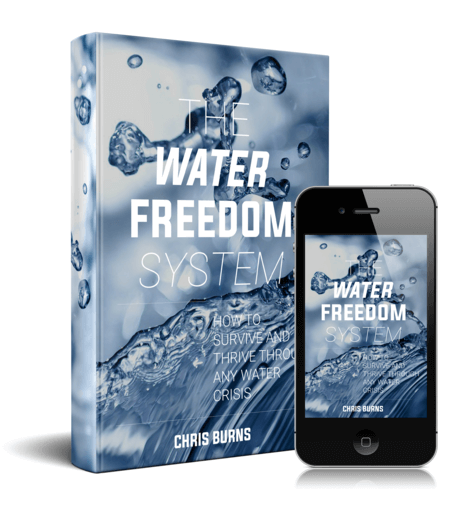
How to Safe $$$ by Creating Your Own Water Supply
EXCLUSIVE step-by-step guide showing you EXACTLY how to create your own “home oasis” TODAY…and how to survive any tough century long drought…
Water Purification Methods
Before you can drink rainwater, you need to purify it. You can do this with sedimentation, using sand and charcoal filters, and adding chlorine. Solar-powered water pumps can also help, using the sun’s energy to pump water.
By setting up rainwater collection and purification, you can save water in an eco-friendly way.
These steps protect the environment and make you less dependent on big systems to supply you with water.
Food Production and Self-Sufficiency
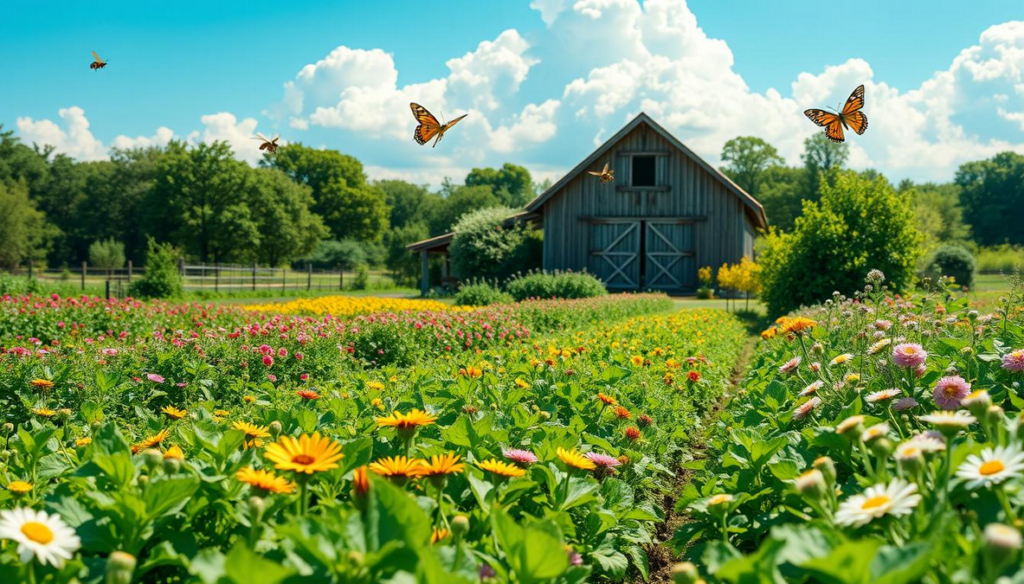
Living off the grid means being self-sufficient in food production. This includes growing your own veggies and herbs, raising chickens for eggs and meat, and foraging for wild foods. Hunting can also be a way to get more protein.
Using permaculture, you can make a food system that’s sustainable and regenerative. This means growing different crops and taking care of animals in a way that’s like nature. By learning these skills, you can make sure you have food and live a healthier, more independent life.
Growing Your Own Food Through Gardening
Gardening is key to making your own food and being self-sufficient. With organic farming and permaculture, you can grow many fruits and veggies. Using raised beds, planting things together, and rotating crops helps the soil and saves water and nutrients.
Livestock
Raising animals is a big part of homesteading.
Chickens, ducks, goats, and cows give you eggs, meat, milk, and dairy. Taking good care of them and keeping them healthy is important for your food supply.
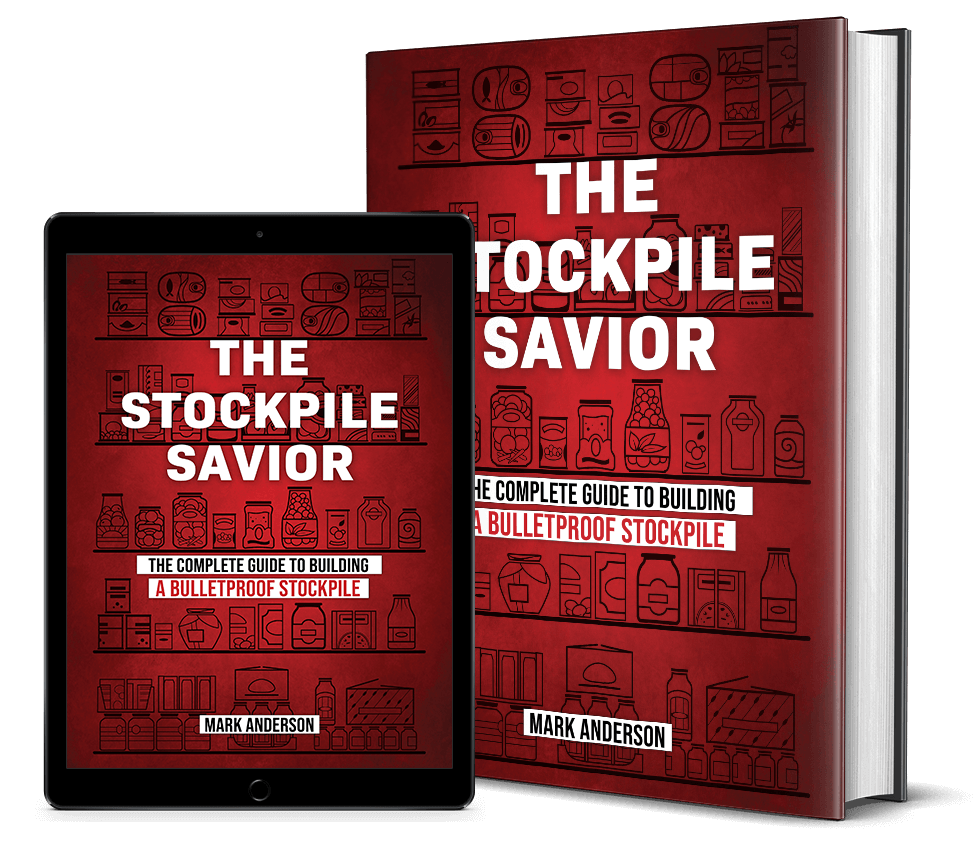
Discover how to build a 100+ days stockpile from scratch, in under 10 days!
This is the ultimate guide to building a bulletproof stockpile that takes you from being uncertain about your preps to being 100% confident that your family will comfortably survive the first 100 days & beyond of any disaster.
Foraging
Foraging for wild foods like berries, mushrooms, and greens can make your diet more varied and secure. Knowing what plants are safe to pick, how to pick them, and their nutritional value is key. This knowledge makes foraging successful.
Hunting
Hunting is a great way to get protein and is a valuable skill for living off the grid. Knowing about local wildlife, the rules for hunting, and how to hunt ethically is important. Techniques like smoking, curing, and freezing help you keep your food fresh for a long time.
Conclusion
Living off the grid is a journey that brings more freedom, care for the environment, and a fulfilling life. With careful planning and the right steps, it can be a rewarding change. You’ll face some costs and challenges at first, but the long-term gains in self-sufficiency, caring for nature, and saving money are clear.
Living off the grid with renewable energy cuts down your energy bills and encourages a simpler, more thoughtful life.
Using renewable energy and smart ways to manage water and waste helps you be more independent and eco-friendly.
Even though you might face issues like less light in winter or missing modern comforts, being creative and strong can help overcome these problems.
Off-grid living lets you live life on your terms, in harmony with nature and your personal growth.
As more people choose this path, we’re moving towards valuing simplicity, strength, and a deeper bond with our planet.
By going off the grid, you’re embracing a sustainable future that benefits both you and the world.

